There is an ongoing discussion on whether its worthwhile to insulate the floor on camper van conversions. Some believe that there is little heat loss through the floor vs the walls and ceiling. This test attempts to provide a direct measurement of heat loss through the ceiling vs heat loss through the floor under cold weather conditions. In an attempt to consider radiation as well as conductive and convective heat loss, the surface temperatures differences across the ceiling and the floor rather than the outside ambient air temperature.
The test covers three days of cold weather in order to include both clear and cloudy weather.
If you want to skip over the details of how the test was setup and go right to the bottom line, then go to the Results heading.
Test Setup
The van is a white ProMaster 1500, high roof, 136 inch wheelbase. The back of the van was facing south. Both the ceiling and the floor are insulated to approximately R7.
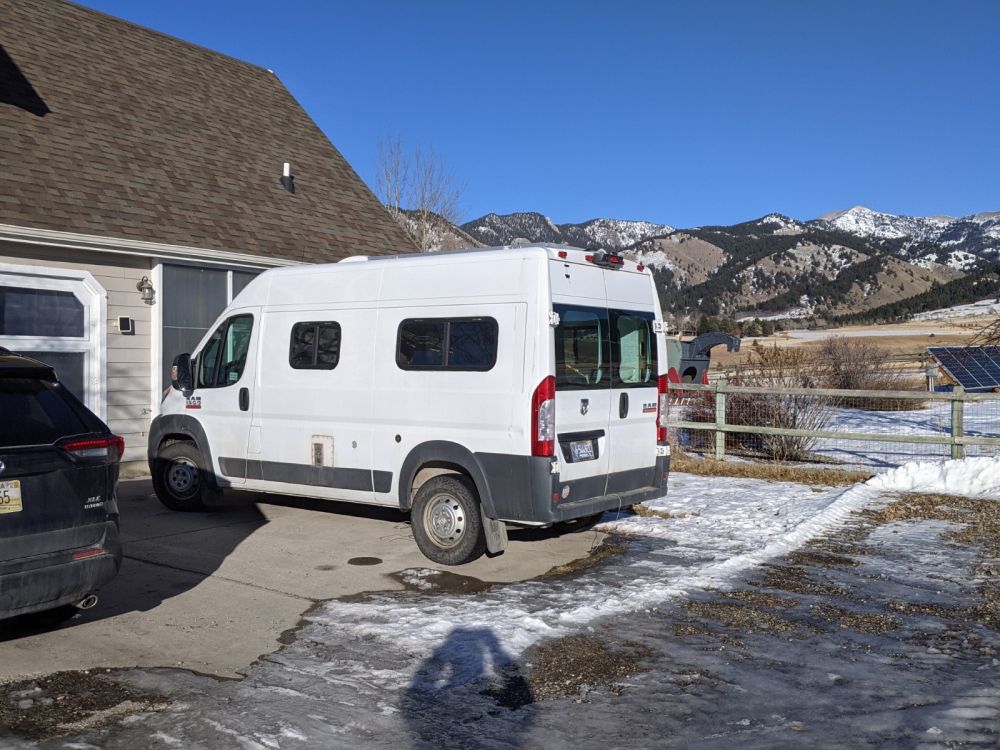
For the roof, a temperature sensor was mounted right on the sheet metal and a 2nd sensor was mounted 2 inches above the sheet metal. So, the first gets the temperature of the sheet metal and the 2nd the temperature of the air above the sheet metal.
The sensor mounted to the sheet metal is first coated with thermal paste and then taped to the sheet metal with tape that has about the same reflectivity as the van white paint. The thermal paste thermally bonds the sensor to the sheet metal, so that you get the true temperature of the sheet metal. The air sensor is mounted to a piece of Polyiso insulation. The Polyiso supports the sensor without influencing its temperature and also shields it from direct sun.
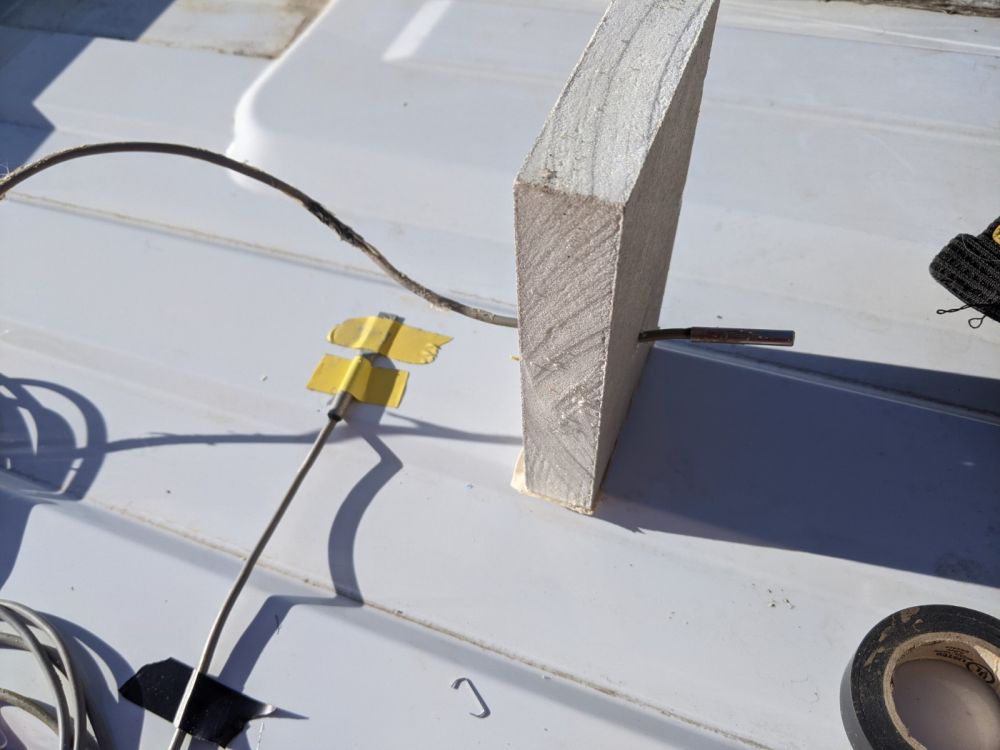
The same setup is used for 1) the ceiling below roof sensor location, 2) the floor about half way back in the van, and 3) under the floor sheet metal also about half way back.
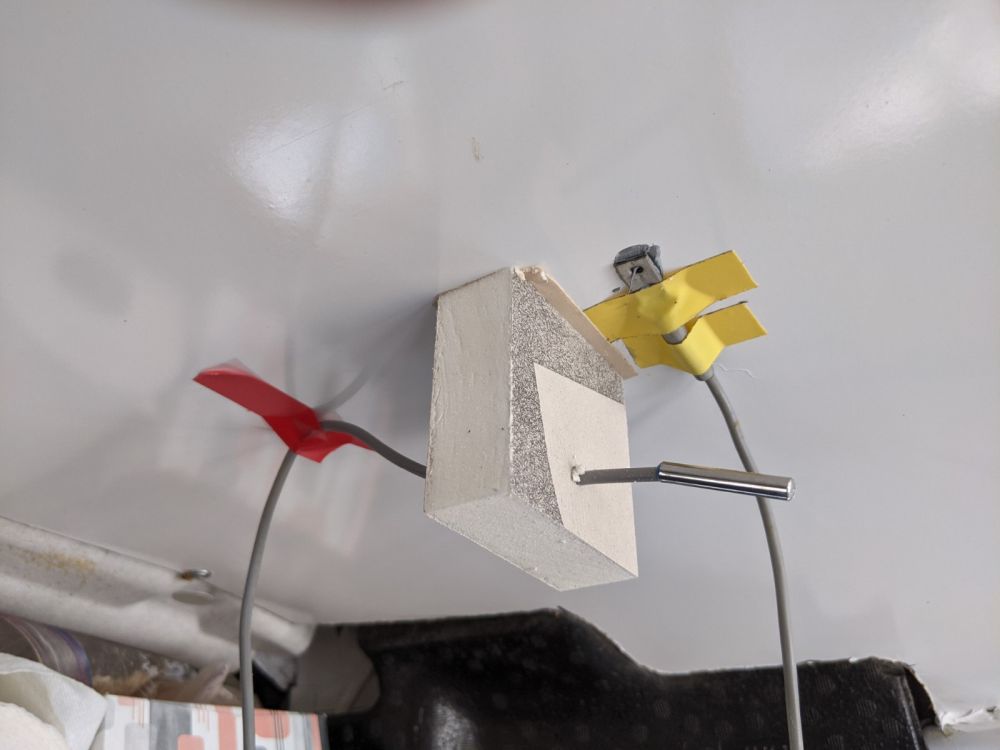
In addition, a sensor was taped down to the concrete under the van to get the ground temperature.
There is also a temperature sensor mounted in the middle of the van at about galley counter level.
Each of the sensors is connected to an Onset Computer data logger, which is set to record values at 30 second intervals. The logging went on for about 3 days in order to get both sunny and cloudy periods day and night.
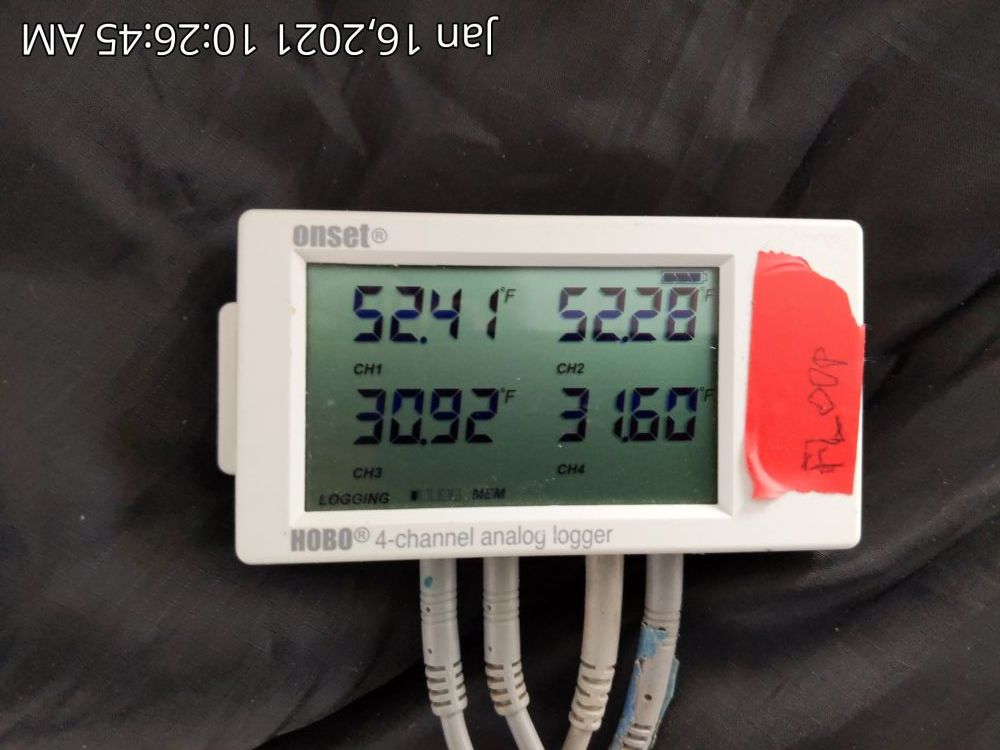
A total of three loggers were used. These are lab quality loggers and thermistor sensors that are good to about plus-minus 0.2F.
The van furnace was on for the whole test and set to maintain a temprature of about 65F in the middle of the van.
Results
The basic idea behind the test is that by mounting temperature sensors directly to the inside and outside surfaces of the roof and of the floor that the heat loss for the roof will be directly proportional to the temperature difference between the inside and the outside surface and the R value of the roof. Likewise the heat loss for the floor will be directly proportional to the temperature difference between the inside and outside surfaces and the R value of the floor.
Heat Loss per sqft = (Tinside surface – Toutside surface) / Rvalue
On my van, the roof and floor are insulated to very nearly the same value (R7), so the heat loss for the roof and floor can be compared by just comparing the the temperature difference for the roof and for the floor. That is, if the difference between the roof inside and outside temps is 20F and the difference for the floor is 10F, then the roof is losing twice as much heat per sqft as the floor. Doing it in this way, includes conductive, convective and radiative heat transfer.
There are two factors at work that make it likely that the roof will lose more heat than the floor. The first is that the air inside the van stratifies with the air near the ceiling being warmer than the air near the floor — this results in more heat loss out the ceiling. This will depend on how much the van furnace keeps the air stirred up. The 2nd factor is that under clear sky conditions, the roof sheet metal at night will radiate to the cold sky cooling below the outside air temperature, which increases ceiling heat loss. And during the day, the solar radiation incident on the roof will heat the sheet metal to above the ambient air temperature, which decreases ceiling heat loss. Since winter days are typically shorter than winter nights, the net effect will be to increase ceiling heat loss compared to the floor, which does not get direct sun or radiate to the night sky.
This plot is sort of the bottom line — it shows the the temperature drop for the roof and the temperature drop for the floor. Wherever the roof drop is greater than the floor drop, the ceiling is loosing more heat, and vice-versa. The graph shows about 3 days and includes day time and night time as well as clear and cloudy conditions — it even shows a period when it was snowing.
Click the graph for larger version
The blue line shows the temperature difference for the ceiling and the orange line shows the difference for the floor. The van furnace cycling off and on causes the saw tooth pattern the lines have.
The plot starts at noon of the 14th, and the first few hours are a clear sky (sunny) day period. There was a light breeze.
For this daytime sunny segment, the ceiling and floor heat loss are about the same because the solar radiation is heating the roof sheet metal, which reduces heat loss. If it were not for the warmer air temps near the ceiling on the inside of the van, the floor heat loss would exceed the roof heat loss.
The part centered on midnight of the 14th is a clear sky night.
In this clear sky night, the roof sheet metal is radiating to the cold night sky, which cools it below the ambient air temperature. The floor does not see the sky, so is not cooled below ambient. The stratification of air inside the van adds to the greater heat loss out the ceiling.
For this time segment, the ceiling heat loss is about 2.35 times the floor heat loss per sqft.
The area around noon of the 15th was nearly clear and calm with sun.
As for the area around noon on the 14th, the roof and floor heat loss are about the same for the same reasons.
For the afternoon of the 15th, the weather goes overcast, and around 5 pm it starts to snow.
The part of the graph from about 6pm on the 15th to about 2am on the 16th where the roof temperature is constant is due to snow falling on the roof, and the snow melting on the sheet metal keeps the roof sheet metal temperature constant at the melting temperature of the snow (32F). Isn’t physics cool!
The morning of the 16th, the weather is clearing
The period around noon of the 16th is pretty clear and calm
Note that the van gets warm enough from the sun that the furnace does not run for several hours.
The evening of the 16th is mostly cloudy and shows somewhat lower heat loss as there is less radiation to the sky.
So, is it worthwhile to insulate the floor?
You might look at the heat loss plot and think that the ceiling loss in cold weather is going to likely be about twice what the floor loss is, so whats the point of doing floor insulation? But, if you have a typical floor with say half inch plywood and maybe some kind of flooring, but no insulation, the Rvalue will be down around R2 or less. If you do insulate with (say) 1 inch Polyiso, the R value will be more like R7. So, the heat loss through an uninsulated floor will be about 4 times an insulated floor. This will about twice the heat loss through your insulated ceiling.
In an otherwise well insulated van with some kind of shades on the windows, an uninsulated floor will be by far your largest heat loss and will be a huge hole in your thermal envelope. When you couple this with how easy and cheap it is to insulate the floor, it just does not (to me) make sense to leave out the floor insulation.
More Results
Here are some additional plots that show some more interesting (I hope) data from the test.
Roof and ceiling temperatures:
The blue line is the air temperature 2 inches above the roof
Orange line is the roof sheet metal temperature
Grey line is the temperature of the ceiling panels surface
Yellow line is temperature 2 inches below the ceiling
Note that the roof surface temperature drops below the air temperature at night and is above the air temperature during the day time (when the sun is heating the sheet metal). I think if the air temperature sensor were mounted a bit higher above the roof (more than the 2 inches), the difference would be greater.
The saw tooth pattern of the ceiling temps is caused by the furnace cycling. Note that around noon there is enough solar gain to the van that the furnace shuts off for a while.
Floor Temperatures:
The Orange line is the temperature 2 inches above the floor
Grey line is the temperature of the surface of the floor
Yellow line is the temperature of the van floor sheet metal (outside)
Green line is the temperature of the ground (concrete)
Note that the inside floor temperature and the temperature of the air just above the floor are in the 45 F to 55F area — about 20F cooler than the air temperatures up by the ceiling. This increases ceiling heat loss compared to floor heat loss.
The graph shows the floor temps near the middle of the floor, but the floor temps vary quite a bit over the floor – colder toward the back of the van. My furnace outlet is just a few inches above the floor, and when the furnace is on, the floor temp in the few sqft near the furnace outlet gets up toward 85F – increasing the heat loss a fair bit in this area.
Mid van air temperature:
The blue line shows the air temperature in the middle of the van – about galley counter height.

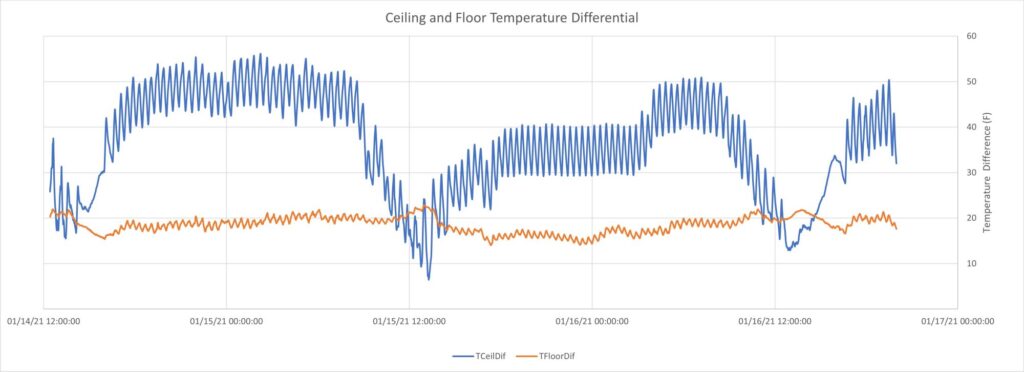
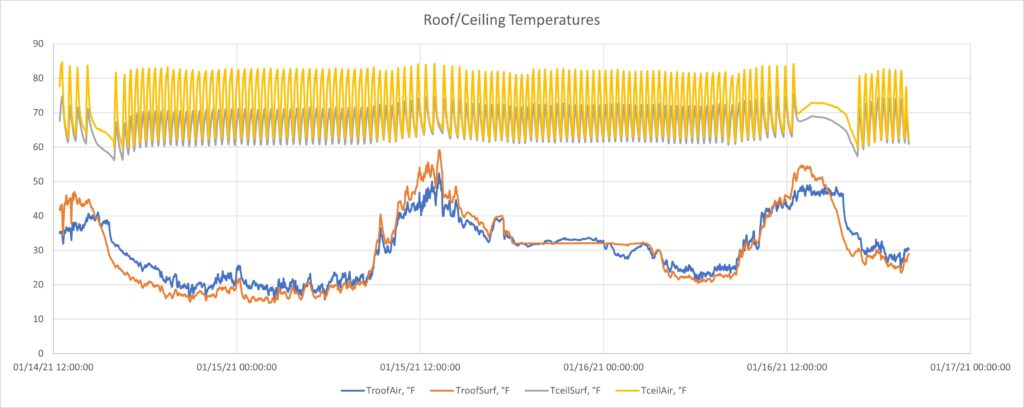
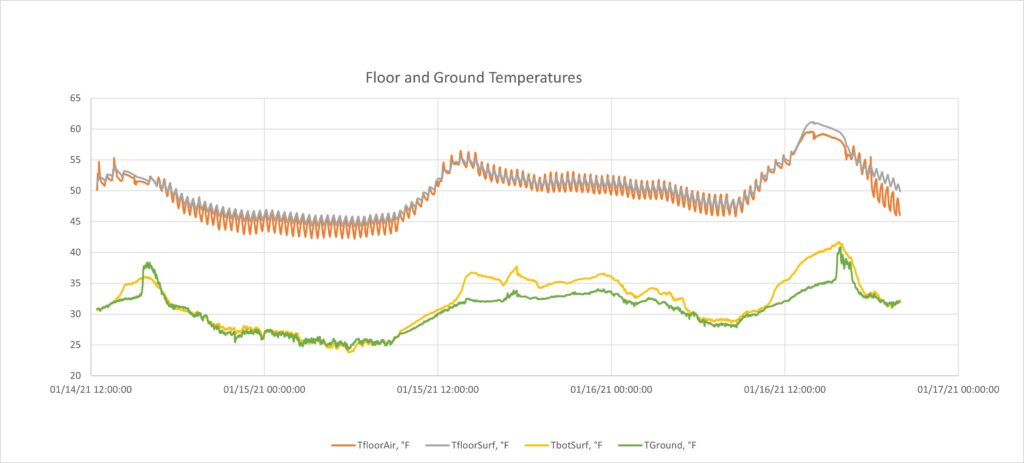
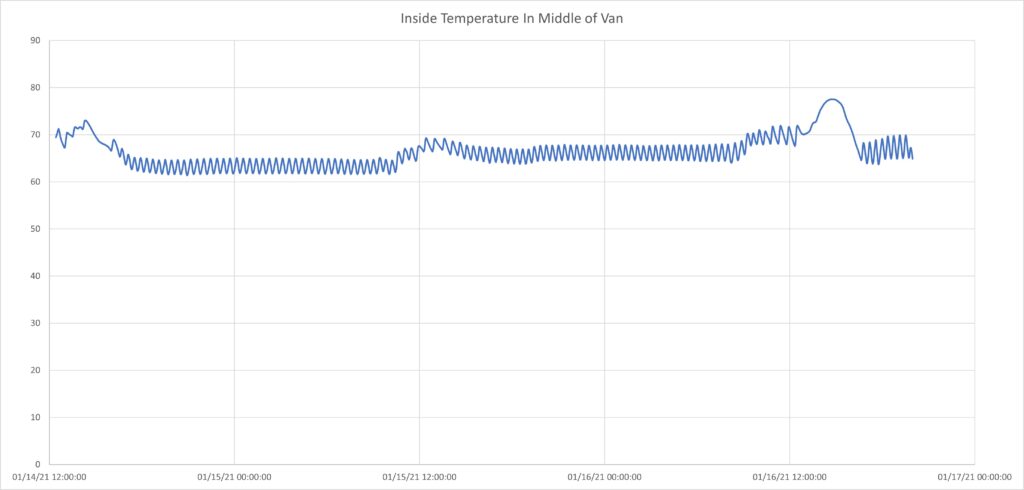
Wow.. I learned about radiative cooling! Defies common sense that the van exterier roof can cool below ambient. Thank you for such a great contribution to the community!
Here is some more on radiative cooling — it is pretty fascinating
Gary
“In an otherwise well insulated van with some kind of shades on the windows, an uninsulated floor will be by far your largest heat loss and will be a huge hole in your thermal envelope. When you couple this with how easy and cheap it is to insulate the floor, it just does not (to me) make sense to leave out the floor insulation.”
*EXACTLY*
Given the popularity of contrary dogma on certain online forums, it goes to show how popularity isn’t a good indicator of best practices.